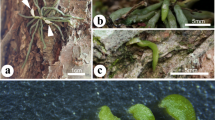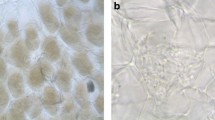Abstract
Mycorrhizal fungi were isolated from the nonphotosynthetic orchid Chamaegastrodia sikokiana and identified as members of Ceratobasidiaceae by phylogenetic analysis of the internal transcribed spacer (ITS) region of ribosomal deoxyribonucleic acid. The ITS sequences were similar among geographically separated samples obtained from Mt. Kiyosumi in Chiba Prefecture and Mt. Yokokura in Kochi Prefecture. One of the isolated fungi, KI1-2, formed ectomycorrhiza on seedlings of Abies firma in pot culture, suggesting that tripartite symbiosis exists among C. sikokiana, mycorrhizal fungi, and A. firma in nature, and carbon compounds are supplied from A. firma to C. sikokiana through the hyphae of the mycorrhizal fungi. To our knowledge, this is the second study to suggest the involvement of Ceratobasidiaceae fungi in tripartite symbiosis with achlorophyllous orchids and photosynthetic host plants.



Similar content being viewed by others
References
Altschul SF, Madden TL, Schaffer AA, Zhang J, Zhang Z, Miller W, Lipman DJ (1997) Gapped BLAST and PSI-BLAST: a new generation of protein database search programs. Nucleic Acids Res 25:3389–3402
Currah RS (1987) Thanatephorus pennatus sp. nov. isolated from mycorrhizal roots of Calypso bulbosa (Orchidaceae) from Alberta. Can J Bot 65:1957–1960
Felsenstein L (1985) Confidence limits on phylogenies: an approach using the bootstrap. Evolution 39:783–791
Gardes M, Bruns TD (1993) ITS primers with enhanced specificity for basidiomycetes: application to the identification of mycorrhizae and rusts. Mol Ecol 2:133–118
Kimura M (1980) A simple method for estimating evolutionary rates of base substitutions through comparative studies of nucleotide sequences. J Mol Evol 16:111–120
Kirk PM, Cannon PF, David JC, Stalpers JA (eds) (2001) In: Dictionary of the fungi. 9th edn. CABI, Wallingford
Marx DH (1969) Influence of ectotrophic mycorrhizal fungi on resistance or pine roots to pathogenic infections. I. Antagonisum of mycorrhizal fungi to root pathogenic fungi and soil bacteria. Phytopathology 59:153–163
McKendrick SL, Leake JR, Read DJ (2000) Symbiotic germination and development of myco-heterotrophic plants in nature: transfer of carbon from ectomycorrhizal Salix repens and Betula pendula to the orchid Corallorhiza trifida through shared phyphal connections. New Phytol 145:539–548
Page RDM (1996) An application to display phylogenetic tree personal computers. Comp Appl Biosci 12:357–358
Peterson RL, Uetake Y, Zelmer C (1998) Fungal symbiosis with orchid protocorms. Symbiosis 25:29–55
Roberts P (1999) Rhizoctonia-forming fungi. A taxonomic guide. The Herbarium, Royal Botanic Gardens, Kew
Saitou N, Nei M (1987) The neighbor-joining method: a new method for reconstructing phylogenetic trees. Mol Biol Evol 4:406–425
Seidenfaden G (1994) The genus Chamaegastrodia (Orchidaceae). Nord J Bot 14:293–301
Taylor DL, Bruns TD (1997) Independent, specialized invasions of ectomycorrhizal mutualism by two nonphotosynthetic orchids. Proc Nat Acad Sci USA 94:4510–4515
Taylor DL, Bruns TD (1999) Population, habitat and genetic correlates of mycorrhizal specialization in the cheating orchids Corallorhiza maculata and C. mertensiana. Mol Ecol 8:1719–1732
Taylor DL, Bruns TD, Szaro TM, Hodges SA (2003) Divergence in mycorrhizal specialization within Hexalectris spicata (Orchidaceae), a nonphotosynthetic desert orchid. Am J Bot 90:1168–1179
Thompson JD, Higgins DG, Gibson TJ (1994) Clustal W: improving the sensitivity of progressive multiple sequence alignment through sequencing weighting, position sequence gap penalties and weight matrix choice. Nucleic Acids Res 22:4673–4680
Warcup JH (1985) Rhizanthella gardneri (Orchidaceae), Its Rhizoctonia endophyte and close association with Melaleuca uncinata (Myrtaceae) in western Australia. New Phytol 99:273–280
Warcup JH (1991) The Rhizoctonia endophytes of Rhizanthella (Orchidaceae). Mycol Res 95:656–641
Warcup JH, Talbot PHB (1967) Perfect states of Rhizoctonias associated with orchids. New Phytol 66:631–641
Weising K, Nybom H, Wolff K, Meyer W (1995) DNA fingerprinting in plants and fungi. CRC, Boca Raton
Acknowledgments
We thank Dr. Toshimitsu Fukiharu, Natural History Museum and Institute, Chiba, Mr. Noritoshi Inagaki, Kochi Prefectural Makino Botanical Garden, and Mr. Kazuo Mori, plant fancier in Hyogo Prefecture for their kind help in C. sikokiana sampling. We also thank Ms. Shiho Ikeda for technical assistance in DNA analyses.
Author information
Authors and Affiliations
Corresponding author
Rights and permissions
About this article
Cite this article
Yagame, T., Yamato, M., Suzuki, A. et al. Ceratobasidiaceae mycorrhizal fungi isolated from nonphotosynthetic orchid Chamaegastrodia sikokiana . Mycorrhiza 18, 97–101 (2008). https://doi.org/10.1007/s00572-007-0155-0
Received:
Accepted:
Published:
Issue Date:
DOI: https://doi.org/10.1007/s00572-007-0155-0




